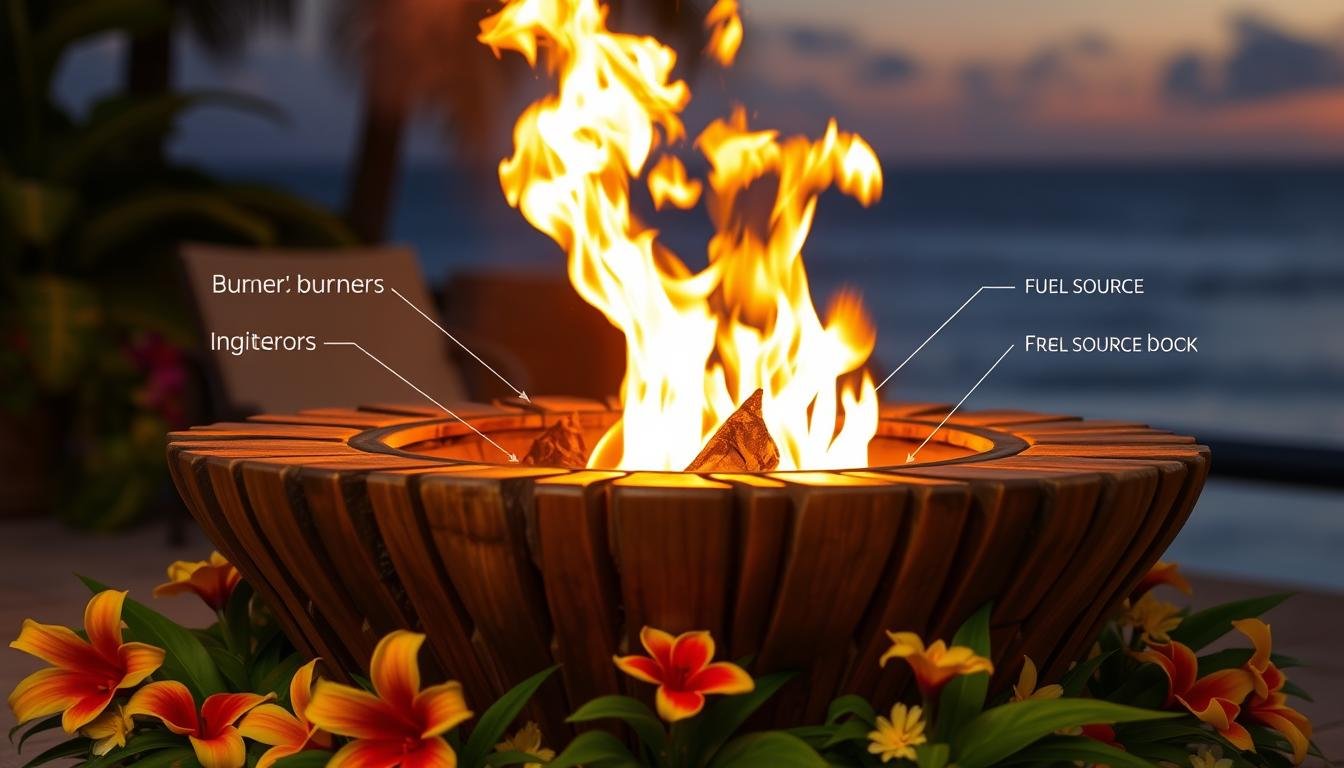A fire pit is a wonderful addition to any backyard, providing warmth, ambiance, and a central gathering place for friends and family.
To keep your outdoor living space functional and beautiful, regular maintenance is essential.

Proper care techniques vary depending on the cover material, but the benefits are universal: extending the lifespan of your fire pit and ensuring it remains protected from the elements.
By following simple cleaning procedures and seasonal care recommendations, you can maximize the functionality of your cover and preserve its appearance.
Why Fire Pit Covers Are Essential for Protection
Fire pit covers play a vital role in shielding your outdoor fire pit from harsh weather conditions and debris. By providing a protective barrier, these covers help maintain the longevity and performance of your fire pit.
Protecting Against Weather Elements
A cover serves as the first line of defense against various environmental factors, including rain, snow, and UV exposure, which can damage your fire pit’s surface and internal components. Without proper protection, your fire pit is vulnerable to rust formation, corrosion, and premature aging, especially if it’s made of metal materials.
| Weather Element | Potential Damage | Protection Offered by Cover |
|---|---|---|
| Rain | Rust and corrosion | Waterproof barrier |
| Snow | Weight damage and rust | Snow deflection and waterproofing |
| UV Exposure | Discoloration and material degradation | UV-resistant materials |
Preventing Debris Accumulation
Covers prevent leaves, twigs, insects, and other debris from accumulating inside your fire pit, which could otherwise create cleaning challenges and potential safety hazards. By keeping your fire pit clean, you can ensure it remains in top condition year-round.
Using a cover significantly reduces the buildup of debris and rust, keeping your pit in good condition. Quality covers help maintain your fire pit’s appearance by preventing discoloration, staining, and other cosmetic damage caused by environmental exposure.
Types of Fire Pit Covers and Their Maintenance Needs
Fire pit covers come in various materials, each with its unique characteristics and maintenance requirements. The right cover not only protects your fire pit from the elements but also enhances its aesthetic appeal. Understanding the specific needs of your fire pit cover is essential for maximizing its protective capabilities and extending its useful life.
Metal Covers: Rust Prevention and Care
Metal covers are known for their exceptional durability and ability to withstand harsh weather conditions. However, they require specific care to prevent rust formation. Regular cleaning with a mild detergent and applying protective coatings can maintain their integrity. It’s also important to dry the cover thoroughly after cleaning to prevent water spots.
Rust prevention is key to maintaining metal fire pit covers. Using a rust-inhibiting coating can significantly extend the cover’s lifespan. Additionally, inspecting the cover regularly for signs of rust and addressing them promptly can prevent damage.
Vinyl and Polyester Covers: Cleaning and Preservation
Vinyl and polyester covers are popular for their water-resistance and affordability. To maintain these covers, gentle cleaning with mild soap solutions is recommended. Avoid using harsh chemicals or abrasive materials that can cause material degradation over time. Regular cleaning and proper storage when not in use can help preserve their quality.
It’s also worth noting that UV resistance is an important factor for vinyl and polyester covers, as prolonged exposure to sunlight can cause fading and weakening of the material. Applying a UV protectant can help mitigate these effects.
Glass Covers: Special Handling Requirements
Glass covers provide an elegant aesthetic while allowing visibility of decorative fire media. They require careful handling to prevent chips or cracks. Special cleaning products designed for glass surfaces should be used to maintain clarity. It’s also important to avoid extreme temperature changes, as glass can be susceptible to thermal shock.
When handling glass covers, gentle care is paramount. Avoid using abrasive cleaners or scrubbers that can scratch the surface. Regular inspection for any signs of damage and addressing them promptly can help maintain the cover’s integrity.
| Cover Type | Maintenance Needs | Key Considerations |
|---|---|---|
| Metal | Regular cleaning, rust prevention | Rust-inhibiting coatings, dry thoroughly after cleaning |
| Vinyl/Polyester | Gentle cleaning, UV protection | Mild soap solutions, avoid harsh chemicals |
| Glass | Careful handling, special cleaning products | Avoid extreme temperature changes, gentle cleaners |
“The longevity of your fire pit cover depends on the material and how well you maintain it. Regular maintenance not only extends the cover’s life but also ensures your fire pit remains in good condition.”
Understanding the unique vulnerabilities of each cover type is crucial. Metal covers are susceptible to rust, fabric covers to UV damage, and glass covers to thermal shock if not properly maintained. By acknowledging these vulnerabilities and taking appropriate maintenance measures, you can significantly extend the lifespan of your fire pit cover.
Fire Pit Cover Maintenance: Routine Cleaning Procedures
The key to extending the life of your fire pit cover lies in consistent and proper cleaning procedures. Regular maintenance not only keeps your cover looking its best but also ensures it continues to protect your fire pit effectively.
Weekly Maintenance Tasks
To keep your fire pit cover in top condition, weekly maintenance is essential. This includes:
- Removing surface debris to prevent accumulation.
- Wiping down the cover with a soft cloth to remove dirt and grime.
- Inspecting for any developing issues such as small tears or water pooling.
For fabric covers, use a soft brush to gently remove dirt and debris before applying a mild soap solution for deeper cleaning. It’s crucial to allow the cover to dry completely before storage to prevent moisture-related issues.
Deep Cleaning Methods
Deep cleaning should be performed monthly or seasonally, depending on your climate and usage patterns. This involves thorough washing and protective treatments to maintain the cover’s integrity.
For stubborn stains or soot buildup on your fire pit, create a paste using baking soda and water, apply it to the affected area, and scrub gently. After scrubbing, rinse your fire pit with clean water to remove any soap residue and dry it thoroughly with a towel to prevent rust.
- Metal covers benefit from regular wipe-downs with a damp cloth and periodic application of appropriate metal protectants to prevent oxidation and maintain finish.
- Always follow manufacturer guidelines for cleaning products, as harsh chemicals can damage protective coatings on many cover materials.
- Establish a regular cleaning schedule based on your local environment – covers in areas with high pollen, near trees, or in extreme weather conditions will require more frequent attention.
After cleaning, ensure the cover is completely dry before placing it back on your fire pit to prevent moisture-related issues like mold or mildew growth. By following these routine cleaning procedures, you can significantly extend the lifespan of your fire pit cover.
Seasonal Care for Your Fire Pit Cover
To ensure your fire pit remains in good condition, it’s crucial to adapt your maintenance routine to the changing seasons. Different times of the year bring different challenges for your cover, from harsh weather conditions to debris accumulation.
Spring and Summer Maintenance
As spring begins, focus on cleaning off winter residue and checking for any damage from freezing temperatures. Apply protective treatments before the heavy use season starts. During summer months, protect your cover from UV damage by using UV-resistant sprays on fabric covers or storing the cover in shaded areas when the fire pit is in frequent use.
Regular maintenance during these seasons can significantly extend the life of your cover. Consider the following practices:
- Clean the cover regularly to prevent dirt buildup.
- Inspect the cover for any signs of wear or damage.
- Apply protective coatings as needed.
Fall and Winter Protection Strategies
As fall approaches, increase cleaning frequency to remove fallen leaves and debris that can trap moisture against your cover and cause premature deterioration. In winter, ensure your cover is completely secure to withstand weather conditions, and consider additional protection like waterproofing treatments.
Here’s a summary of key actions for each season:
| Season | Key Maintenance Tasks |
|---|---|
| Spring | Clean off winter residue, check for damage, apply protective treatments. |
| Summer | Protect from UV damage, store in shaded areas when not in use. |
| Fall | Increase cleaning frequency, remove debris. |
| Winter | Secure the cover, consider waterproofing treatments. |

By following these seasonal care tips, you can ensure your fire pit cover remains in good condition throughout the year, providing effective protection and extending its lifespan.
Extending Your Cover’s Lifespan: Best Practices
To maximize the lifespan of your fire pit cover, it’s essential to follow best practices that ensure durability and protection. Regular inspection of your fire pit is crucial to identify signs of rust, cracks, or other damage. Addressing these issues promptly will prevent them from worsening.
Proper Techniques for Installation and Removal
When installing or removing your fire pit cover, it’s crucial to use gentle, even movements to avoid creating stress points that can lead to tears, especially in fabric covers. Ensuring the fire pit is completely cool before covering is also vital to prevent heat damage to the cover material.
- Secure your cover properly using the provided straps, drawstrings, or weights to prevent wind damage.
- Avoid dragging covers across rough surfaces when removing or storing them.
- Keep sharp objects away from your cover during installation, removal, and storage.
Avoiding Common Factors of Damage
Regularly inspect your fire pit cover for signs of wear and tear. Addressing small damage immediately can prevent minor issues from becoming major problems.
| Damage Type | Prevention Method | Repair Action |
|---|---|---|
| Tears and Punctures | Handle with care, avoid sharp objects | Patch or replace the cover |
| Abrasions | Avoid dragging on rough surfaces | Apply a waterproof coating |
| Mold and Mildew | Ensure dry storage, regular cleaning | Clean with a mild detergent solution |
By following these best practices and being mindful of the common damage factors, you can significantly extend the lifespan of your fire pit cover and ensure it continues to protect your fire pit effectively.
Troubleshooting Common Cover Issues
Fire pit covers, like any other outdoor protection, can encounter problems that require immediate attention to prevent further damage. Regular maintenance and prompt troubleshooting are key to extending the life of your cover and ensuring your fire pit remains in good condition.
Addressing Tears and Punctures
Small tears and punctures in your cover can often be repaired using patch kits specifically designed for your cover material. Whether you have a vinyl, canvas, or polyester cover, there are different repair approaches to consider. For instance, a vinyl cover might require a patch kit with adhesive-backed vinyl patches, while a canvas cover might need a more heavy-duty fabric repair kit.
When repairing tears, it’s essential to clean the area around the damage thoroughly before applying the patch. This ensures a strong bond between the patch and the cover material, making the repair more durable.
Managing Mold and Mildew
Mold and mildew can be a common issue for fire pit covers, especially in humid or wet conditions. To address this, create a solution of one part white vinegar to four parts water. Apply this solution to the affected areas, scrub gently with a soft-bristled brush, and then thoroughly rinse the cover with clean water. Allow the cover to dry completely before storing it.
Regular cleaning and ensuring the cover is dry before storage can help prevent mold and mildew from forming in the first place.
Dealing with Discoloration
Discoloration from sun exposure is another common issue that can affect the appearance of your cover. Specialized UV protectant products can sometimes address this problem, helping to restore the cover’s original color. However, severe fading may be a sign that it’s time to consider replacing the cover.
To prevent discoloration, consider using a cover made from UV-resistant materials or applying a UV protectant spray regularly.

Other common issues with fire pit covers include water pooling, which can indicate improper drainage or fit. Adjusting the installation to create proper runoff can prevent the weight of collected water from damaging the cover. Zippers and fasteners that become difficult to operate may need cleaning and lubrication with a silicone-based product. Shrinkage in fabric covers can occur over time, making them difficult to install. In such cases, looking for replacement options is advisable.
| Issue | Solution |
|---|---|
| Tears and Punctures | Use patch kits designed for the cover material |
| Mold and Mildew | Clean with vinegar solution and dry thoroughly |
| Discoloration | Apply UV protectant products or consider replacement |
By addressing these common issues promptly and properly, you can extend the life of your fire pit cover and keep your fire pit in excellent condition for years to come.
When to Replace Your Fire Pit Cover
As your fire pit cover ages, it’s essential to assess its condition to determine if it’s time for a replacement. A fire pit cover plays a crucial role in protecting your fire pit from the elements and debris. Over time, the cover can deteriorate due to exposure to weather conditions, usage, and other factors.
Signs of Irreparable Damage
Several signs indicate that your fire pit cover has suffered irreparable damage and needs to be replaced. These include:
- Multiple tears, especially along seams or stress points, often indicate the structural integrity of the cover has been compromised beyond practical repair.
- Significant material degradation such as brittleness, cracking, or thinning suggests the protective qualities of the cover have diminished and replacement is necessary.
- Persistent mold or mildew problems that return despite proper cleaning typically indicate the material has become permanently compromised.
When you notice any of these signs, it’s crucial to consider replacing your fire pit cover to ensure continued protection for your fire pit.
Choosing a Replacement Cover
When selecting a replacement cover, consider upgrading to more durable materials or designs based on the issues that led to your previous cover’s failure. Look for covers made from durable, weather-resistant materials like heavy-duty vinyl or polyester. Ensure it fits snugly over your fire pit to keep out moisture and debris.
For fire pits with grilling surfaces, consider covers that include vents to allow for airflow and prevent mold. Measure your fire pit carefully before purchasing a replacement – an ill-fitting cover will wear out quickly and provide inadequate protection.
Additionally, look for covers with enhanced features like reinforced corners, UV protection, and proper ventilation to address any shortcomings you experienced with your previous cover. Consider seasonal timing for replacement – end-of-season sales can provide cost savings on high-quality covers that will be ready for the next season of use.
Storage Solutions When Not in Use
Proper storage of your fire pit cover during the off-season is crucial for protecting it from damage and ensuring it remains in good condition. A well-maintained cover not only prolongs its lifespan but also ensures your fire pit remains protected.
Off-Season Storage Tips
To store your fire pit cover effectively, start by cleaning and completely drying it. This prevents mold, mildew, and unpleasant odors from developing during storage.
- Store fabric covers in breathable bags to allow any residual moisture to escape.
- Choose a storage location away from extreme temperatures and direct sunlight.
- Consider using cedar blocks or other natural repellents to discourage insects and rodents.
Additionally, labeling your stored cover with the size and fire pit model it fits can help avoid confusion if you own multiple outdoor items requiring covers.
Proper Folding and Handling Techniques
When folding your cover, do so along its natural seams to minimize creasing and stress on the material. This helps prevent premature wear and potential leakage points.
- Avoid storing heavy items on top of your folded cover to prevent damage to waterproof coatings.
- Use gentle handling techniques to prevent unnecessary strain on the cover material.
By following these storage and handling techniques, you can significantly extend the life of your fire pit cover and ensure it remains in good condition for the next season.
Conclusion: Maximizing Your Fire Pit Cover’s Functionality
Regular care for your fire pit cover translates into extended protection and enjoyment of your fire pit. By understanding the importance of maintenance and implementing a routine that includes weekly quick-cleans and seasonal deep cleaning, you can significantly extend the lifespan of your cover.
A comprehensive approach to maintenance involves not just regular cleaning, but also proper installation, appropriate storage, and prompt repairs. It’s essential to follow the manufacturer’s guidelines for your specific cover type, as different materials have unique care requirements.
Investing in a higher-quality fire pit cover may seem costly upfront, but it often results in better protection and a longer service life. By protecting your cover, you’re ultimately safeguarding your fire pit, which enhances your outdoor living space and provides enjoyment for years to come.
By implementing the maintenance tips outlined in this guide, you’ll not only maximize the functionality and lifespan of your cover but also ensure your fire pit remains in excellent condition. This proactive approach is an investment that pays dividends through reduced replacement costs over time and continued enjoyment of your outdoor space.

John Carter is a firepit expert with 10+ years of experience in outdoor heating solutions. He specializes in firepit selection, installation, and maintenance, sharing tips on DIY projects, product reviews, and backyard entertainment. Passionate about creating cozy outdoor spaces, he helps homeowners choose the perfect firepit for their needs


